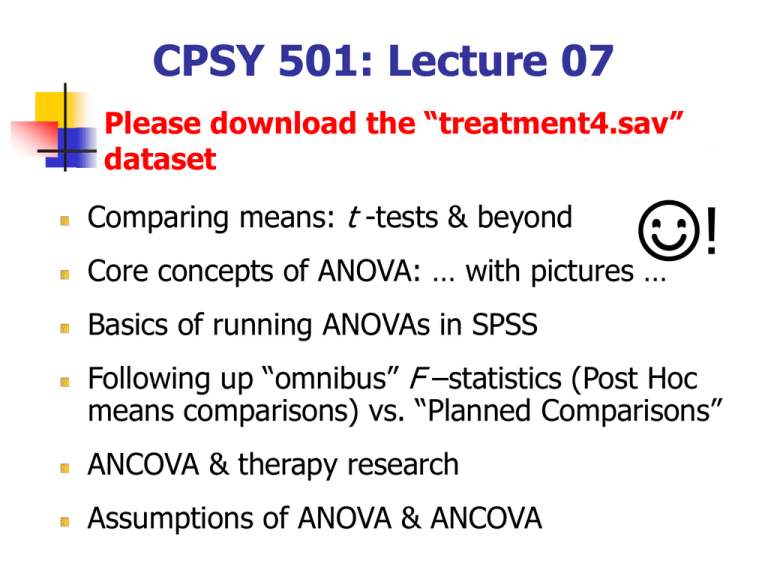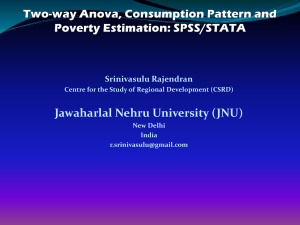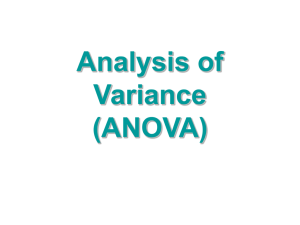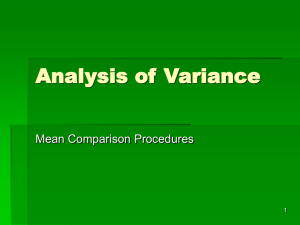07-ANOVA
advertisement

CPSY 501: Lecture 07 Please download the “treatment4.sav” dataset ☺! Core concepts of ANOVA: … with pictures … Comparing means: t -tests & beyond Basics of running ANOVAs in SPSS Following up “omnibus” F –statistics (Post Hoc means comparisons) vs. “Planned Comparisons” ANCOVA & therapy research Assumptions of ANOVA & ANCOVA ANOVA: Trends in Research As the following Figure shows, there are major trends in usage patterns of statistical tools (Buhi & al., 2007). ANOVA is still a major tool, although its prominence is declining while Structural Equation Modelling (SEM) is increasing in the literature indexed by PsychINFO. ANOVA is also a conceptual “building block” for stats more broadly. Summary: Versions of ANOVA (comparing means of more than 2 Groups) One-way ANOVA: One IV, with more than two groups (“levels”) [& parametric DV, as for all ANOVAs…] Example: ___________ [treatment4 data set] Factorial (“between subjects”) ANOVAs: Two or more IVs, and interactions between IVs Example: “2 x 3 factorial ANOVA” = ________ Repeated Measures (“within subjects”) ANOVAs: Each participant is observed more than once on each IV (one or more IVs). Example: “RM ANOVA on Time” = ________ Versions of ANOVA … (cont.) Mixed (Between-Within) ANOVA: ANOVAs where 1 or more IVs are “betw,” & 1 or more are “within” Example: “3 x (3) mixed design ANOVA” =… MANOVA: ANOVAs with 2 or more outcome variables, correlated, & in the same analysis Examples? _______________ ANCOVA: Any of the above designs, & trying to “control for” an “extraneous” influence on the DV Example? video-primed anxiety & phobias Core Concepts of ANOVA Cannot do multiple t-tests to compare multiple groups, because the probability level across the whole set of comparisons (i.e. the “family-wise” error, FWE) will be greater than .05 [Field, p. 310]* ANOVA is approx.** a form of regression, where all “predictor” variables are categorical (usually with more than two different categories for a One-Way). F-Ratio: “MSmodel/MSresidual” As such, it is an indicator of the size of the prediction model (i.e., the effect size of differences between cells or groups) Core Concepts of ANOVA (cont.) F-Ratio “logic”: The “model” vs “residual” distinction can also be described as “between cell” variation as distinguished from “within cell” variation. “Cells” are the sets of observations (data) on all possible groups of participants (or “subjects”). Groups of participants are formed from all possible combinations of values of all IVs. In the treatment4 data set, the cells for today are: CBT grp, CBS grp, & WL control (“outcome” as DV). A Picture–within cell variation Error bar charts help show both the “betw” and “w/i” variation Confidence intervals around cell means describe within-cell variation (residual) Cell mean differences describe between-cell variation (effect of IV) SPSS: graphs >…> error bar > “simple” & “groups of cases” > use DV & IV for the One-Way ANOVA … 95% CI depression levels at outcome of therapy 7 6 5 4 3 2 1 CBT Church-based support group Treatment Type WL Control Another Picture: repeated measures SPSS: graphs >…> error bar > “simple” & “separate variables” > use all depression scores as DVs to show repeated measures ANOVA … The graph shows the decrease in depression scores over treatment and at follow-up, for the whole group (“collapsed” across all treatment groups) 8 7 95% CI 6 5 4 3 2 Another Picture SPSS: graphs >…> error bar > “clustered” & “separate variables” > use DVs & IVs for Mixed-design ANOVA repeated measures for each group depression levels prior to therapy depression levels at outcome of therapy depression levels 6 month after therapy 10 8 95% CI 6 4 2 0 CBT Church-based support group Treatment Type WL Control Running ANOVAs in SPSS … All univariate ANOVAs can be obtained through: analyse > general linear model > univariate… - Outcome in “dependent variable” - IVs in “fixed factor(s)” (for most designs we use) - effect size in >options>“estimates of effect size” - means for each group in >options>“descriptives” [in ANCOVA, the “third variables” go in “covariates”] If overall model is significant, determine where the specific group differences are (post hoc tests). Or Planned contrasts can replace this “omnibus” test. Interpreting SPSS Output: an ANOVA Tests of Between-Subjects Effects depression symptoms Dependent Variable: Level of trauma symptoms Source Corrected Model Intercept TREATMNT Error Total Corrected Total Type III Sum of Squares 57.267a 374.533 57.267 40.200 472.000 97.467 df 2 1 2 27 30 29 Mean Square 28.633 374.533 28.633 1.489 F 19.231 251.552 19.231 Sig . .000 .000 .000 Eta Sq uared .588 .903 .588 a. R Squared = .588 (Adjusted R Sq uared = .557) There is a significant effect of treatment type on depression, F (2,27) = 19.23, p < .001 This is a strong / large effect, η2 = 59% 95% CI depression levels at outcome of therapy 7 6 5 4 3 2 1 CBT Church-based support group Treatment Type WL Control Example (continued): Eta-squared is an estimate of the overall effect of the IV, but which means are different from the others? Minimally: We can say that the highest cell mean is significantly different from the lowest cell mean ….but what about the cell means “in the middle”? To find out, we can conduct “Post Hoc (after the fact) tests of mean differences” For post hoc comparisons, use analyse >general linear model > univariate >options >”display means for” “compare main effects” Determining Specific Differences: Post Hoc means comparison tests Definition: Identifying specific between-groups differences by adjusting the alpha levels of each comparison test to ensure that the “significance level” across the overall analysis remains at .05. Advantages: allows for more complete exploration of the results; simple to get these results (in SPSS) Disadvantages: harder to “find” significant differences than with planned comparisons; also, as number of groups increases, it also becomes harder to distinguish significant differences Post Hoc comparisons (cont.) Uses of post hoc strategies: When you are doing exploratory research (i.e., without specific directional hypotheses), or if there are preplanned comparisons that are “non-orthogonal” Procedure: choose what post hoc tests should be performed by clicking the appropriate boxes in analyse >general linear model >univariate > “post hoc” Types of Post Hoc Tests Tukey or REGW Q (Ryan, Einot, Gabriel & Welch): most powerful, accurate options, if your groups are of equal size and variances are equal. Gabriel’s or Hochberg’s GT2: For equal variances but different group sizes. Gabriel’s is better when the sizes are relatively similar (say, within 10% of each other); Hochberg’s is better in other situations. Games-Howell: for when equality of variances is violated. (If you are not sure, you can always try this one in addition to one of the others, and see if the answers are similar.) Notes on Post hoc comparisons SPSS has limited planned comparison and post hoc options “built in” to the menu system. Use MR for more complex options. [syntax commands also provide more options] Use either the Bonferroni or Sidak confidence interval adjustments Pairwise comparisons tables help us to see where specific differences lie Note that there is no option for an “equality of variances not assumed” for post hocs SPSS “post hocs” output Pairwise Comparisons Dependent Variable: depression levels at outcome of therapy (I) Treatment Type CBT Church-based support group W L Control (J) Treatment Type Church-based support group WL Control CBT WL Control CBT Church-based support group Mean Difference (I-J) Std. Error a Sig . 95% Confidence Interval for a Difference Lower Bound Upper Bound -1.000 .546 .234 -2.393 .393 -3.300* 1.000 .546 .546 .000 .234 -4.693 -.393 -1.907 2.393 -2.300* .546 .001 -3.693 -.907 3.300* .546 .000 1.907 4.693 2.300* .546 .001 .907 3.693 Based on estimated marginal means *. The mean difference is significant at the .05 level. a. Adjustment for multiple comparisons: Bonferroni. Multiple Comparisons Dependent Variable: depression levels at outcome of therapy Tukey HSD Bonferroni *Equality of Gamesvariances How ell not assumed (I) Treatment Type CBT (J) Treatment Type Church-based support group WL Control Church-based support group CBT WL Control WL Control CBT CBT Church-based support group Church-based support group WL Control Mean Difference (I-J) Std. Error -1.00 .546 .178 -2.35 .35 -3.30* .546 .000 -4.65 -1.95 1.00 .546 .178 -.35 2.35 -2.30* .546 .001 -3.65 -.95 3.30* .546 .000 1.95 4.65 2.30* .546 .001 .95 3.65 -1.00 .546 .234 -2.39 .39 -3.30* .546 .000 -4.69 -1.91 1.00 .546 .234 -.39 2.39 -2.30* .546 .001 -3.69 -.91 3.30* .546 .000 1.91 4.69 2.30* .546 .001 .91 3.69 -1.00 .492 .133 -2.26 .26 -3.30* .571 .000 -4.76 -1.84 1.00 .492 .133 -.26 2.26 -2.30* .571 .002 -3.76 -.84 Sig . 95% Confidence Interval Lower Bound Upper Bound Church-based support group CBT WL Control WL Control CBT CBT Church-based support group Church-based support group WL Control Church-based support group CBT WL Control WL Control CBT 3.30* .571 .000 1.84 4.76 Church-based support group 2.30* .571 .002 .84 3.76 Based on observed means. *. The mean difference is significant at the .05 level. Summary for Post hocs The various options for testing all say that the control group (WL) is significantly different than treatment groups (CSG & CBT), but the treatment groups are not different from one another Some choices are more “conservative” – with lower significance levels reported Specific Mean Differences in ANOVA, Part 2: Planned comparisons “A Priori” (“before the fact”) or “planned” tests of mean differences between groups also called “planned comparisons” or “planned contrasts” Planned contrasts may help with power, thus making these strategies more “sensitive” (when we have a good conceptual reason to select this strategy) Conducted instead of omnibus F Planned comparisons, like post hoc tests, help to overcome the problem of inflated type 1 error due to conducting multiple significance tests Planned Comparisons between Means Definition: Identifying specific between-groups differences by partitioning the DV total variance (breaking down the variance into component parts, tied to specific cells, for later comparison) Advantages: May be easier to find significant results (tied to specific conceptual issues in the study); & allows for sets of groups to be compared Cautions: There are conceptual limits, ‘trade-offs’ in choosing comparisons; & SPSS options for planned contrasts are limited in Factorial or Repeated Measures designs (so must use MR)* Planned Comparisons (cont.) Weighting Rules (to ensuring Orthogonality): 1. All Positively weighted groups will be compared against all negatively weighted groups 2. The sum of the weights in a comparison must be zero 3. If a particular group is not involved in a comparison, assign it a weight of zero 4. If a variable has been partitioned into one section, it cannot be combined with variables from the other section in subsequent comparisons Using the above rules, what are some examples of possible planned comparisons for our data set? - describe what we want to compare? - what/where do we assign the weights? SPSS Example for our data set “Contrasts” are sets of comparisons among groups (levels of the IV). For example: (a) we can compare a control group with the 2 treatment groups (CBT & CSG vs. WL) (b) we can also compare the two treatment groups (CBT vs. CSG) Contrast (a) = 1, 1, -2 & (b) = 1, -1, 0 We have 2 degrees of freedom, & one contrast for each df this choice illustrates “orthogonality” Planned Comparisons (cont.) Weighting Rules (repeated here for the example) 1. All Positively weighted groups will be compared against all negatively weighted groups 2. The sum of the weights in a comparison must be zero 3. If a particular group is not involved in a comparison, assign it a weight of zero 4. If a variable has been partitioned into one section, it cannot be combined with variables from the other section in subsequent comparisons Planned Comparisons in SPSS First, define your comparison Analyse >compare means >one-way… and assign your weightings: “contrasts” type in each weighting, in the correct order Also, obtain the Levene’s test, and means for each group: “options”> “Descriptives” and “homogeneity of Variance” In the output screen, make sure you select the appropriate result (equality assumed OR equality not assumed) from the “contrast tests” box. Results: reading output Test of Homogeneity of Variances depression levels at outcome of therapy Levene Statistic .795 df1 df2 2 Sig. 27 .462 Results: reading output /CONTRAST= 1 1 -2 /CONTRAST= 1 -1 0 Contrast Tests depression levels at outcome of therapy Assume equal variances Does not assume equal variances Contrast 1 Value of Contrast Std. Error t df Sig. (2-tailed) -5.60 .945 -5.925 27 .000 2 -1.00 .546 -1.833 27 .078 1 -5.60 1.030 -5.439 14.486 .000 -1.00 .492 -2.032 18.000 .057 2 Example data set The control group is different from the average of the treatment groups The difference between the treatment groups is not significant Planned Comparisons: Review Use: When you have specific hypotheses to test (derived from your theory / research questions). It is normal practice to select only orthogonal contrasts for your planned comparisons (i.e., you are only ever comparing independent components of DV variance, defined in connection with IVs) Different formulae are used when the variances are equal (i.e. ‘homogenous’), and when they are unequal. In the SPSS output, assess for homogeneity of variance, and attend to the appropriate results. Planned Comparisons (cont.) Other suggestions for doing planned comparisons: 1. Plan them out when designing your study, not after you have already run your ANOVA 2. Comparisons are tied conceptually to your variables 3. You may not be able to make all the comparisons that you want to make in one study 4. In SPSS, it is possible to manually assign weightings for planned contrasts in 1-way ANOVA & in GLM univariate (using the “contrasts” button); complex designs can also be addressed using Multiple Regression methods. ANOVA Assumption: DV “parametricity” Interval level DV (“quantitative”): look at how you are measuring it Normally distributed DV: Check for outliers; run Kolmogorov-Smirnov & Shapir-Wilks tests Analyze >Descriptive Statistics >Explore >plots “normality plots with tests” Equality of variances: run a Levene’s test Analyse>general linear model>univariate>“options” > “homogeneity tests” [select treatment groups] Independence of scores: look at your design and your data set Assumptions of ANOVA (cont.) However, ANOVA is a fairly robust procedure, that is usable even with some violations of assumptions, under certain conditions. Violations that ANOVA is not robust enough to deal with are a) interval level DV (use non-parametric statistics instead), and b) dependence of scores (use Repeated Measures ANOVA / MLM instead) ANOVA becomes more robust when: a) sample sizes are larger b) the groups are closer to being equal in size c) violations are minor rather than extreme Assumptions of ANOVA (cont.) If normality is violated (after dealing with outliers): a) Check to see if scores on the DV are close to being normal (histogram) and, if so, proceed b) Otherwise, create separate histograms of each group, and if they are skewed in a similar way, proceed: Graphs > histogram > move your IV into the “rows” box c) If the groups are skewed in different ways, use a non-parametric comparison test Assumptions of ANOVA (cont.) If equality of variances is violated: a) Check sample size for each comparison group. If equal (or at least close), you can proceed b) Otherwise, use the Welch’s F procedure to approximate what the F should actually be analyse> compare means > one-way ANOVA > Options c) Remember to also use the appropriate post hoc tests (Games-Howell) Assumptions-testing “Practice” Using the treatment4 data set, assess all the assumptions for a study where “Age” is the IV, and “follow-up” is the DV. What assumptions are violated? For each violation, what should we do? (Treat the different scores in “age” as categories, rather than participants’ actual ages). Introduction to ANCOVA Analysis of variance where 1 or more covariates are included in the model. These covariates are continuous “predictor” variables that are best used as methodological “control” factors to help power. “Covariates” often become IVs when they are conceptually linked to other IVs or to the outcome. ANCOVA works by statistically accounting for part of the variance in the outcome variable, thus altering the F-ratio. (Caution is required when Cov are correlated with IVs – creating conceptual links) Main Use of ANCOVA in Research Reduction of error variance: Covariate(s) related to the DV are included in the model, accounting for some of the within-group error variance, thus reducing MSresid and increasing the F ratio. DV Covariate IV F-ratio = MS Model MS Resid F-ratio = MS Model MS Resid A “Cautious” Use of ANCOVA in Research 1: Studying “confounding” variables: Occasionally, ‘external’ variables, as “Cov,” may systematically influence an experimental manipulation. This can be identified through theory, and statistically “controlled for” by entering them as covariates (but this might not improve the F -ratio). DV IV Covariate? A “Cautious” Use of ANCOVA in Research 2: Solutions “Confounding” variables?: Some authors confuse confounding, ‘external’ variables with another IV. Any time the Cov is ‘linked’ conceptually with another IV or with the DV, then treat the Cov as an IV. Any interactions or interpretable IV-Cov correlations then become part of the analysis. DV IV ‘Covariate’ or ‘IV’? Pre-test Outcome Scores & “ANCOVA” in Therapy Research “Pre-treatment” outcome scores: A common & controversial analysis issue is how to analyze therapy studies when there are pre-treatment differences between experimental groups in symptom levels. Solution: When in doubt, treat pretest scores as another IV, not as a Cov. DV IV Pretest scores = ‘IV’? Assumptions of ANCOVA Parametricity of DV Homogeneity of regression slopes: typical ANOVA assumptions Regression of the DV on the Cov is the same for all groups Can be tested as an interaction between IV & Cov Conceptual independence of Cov & IV (so shared variance is “external” to RQ) Doing ANCOVA in SPSS Identical to GLM ANOVA, except with the addition of one or more variables in the “covariates” box analyse>general linear model>univariate> NB: make sure that the model is on “full factorial” and no longer on “interactions” model that was used to check for homogeneity of correlation slopes. Results of an ANCOVA can be reported as “Controlling/accounting for the influence of the covariate, the effect of the IV on the Outcome is/is not significant, F (dfIV, dferror) = __, p = __.”









